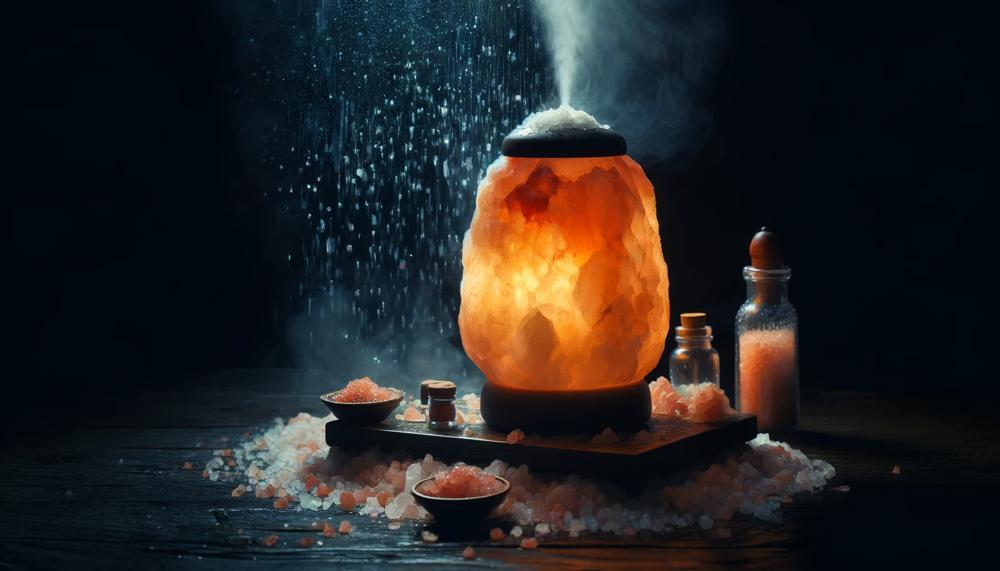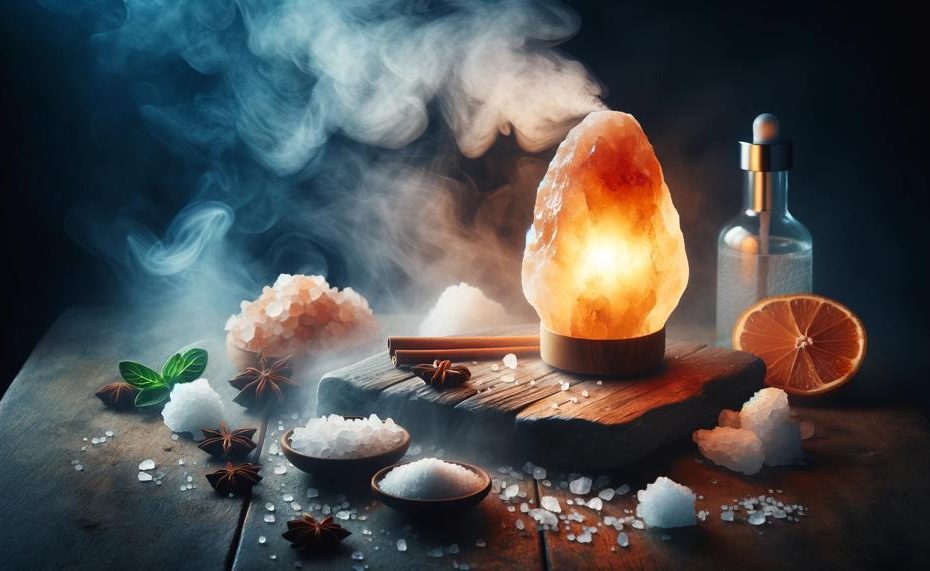As you enter a room, the warm and gentle glow of a salt lamp welcomes you. These natural lamps have gained popularity for their supposed health benefits and soothing ambiance.
But what if you notice that your salt lamp is wet? This unexpected discovery may leave you perplexed and questioning the reason behind it. In this blog post, we will delve into the possible explanations for a wet salt lamp and its impact on its efficacy.
So, why is my salt lamp wet?
Your salt lamp might be wet due to its hygroscopic properties, which means it naturally absorbs moisture from the air. If the lamp is in a humid environment or left out in the open, it can draw in a lot of moisture, leading to condensation on its surface. This can sometimes be so extreme that it looks like the lamp is leaking or melting, but it’s actually just the excess moisture.
So, let’s unravel the mystery of a wet salt lamp together.
Contents
- 1 How Can I Stop My Lamp From Sweating And Melting All Over The Table?
- 2 The Lamp Continues To Continue To Sweat Despite All My Efforts. What Do I Do?
- 3 The Lamp Is Too Bright For Me To Sleep With It On, But I Don’t Want To Turn It Off At Night Because It Will Sweat
- 4 My Lamp Is In The House, But It Does Not Seem To Affect Air Quality
- 5 I Want To Keep My Lamp Clean But Can’t Seem To Find A Way To Clean It Without Melting The Salt. How Do I Do It?
- 6 My Lamp Doesn’t Work When I Turn It On; I Replaced The Bulb, But That Doesn’t Fix The Problem
- 7 The Bulb In My Lamp Is Burning Out Too Often
- 8 The Lamp Bulb Flickers When It Is On
- 9 It Doesn’t Seem That I Can Find New Bulbs For My Lamp Anywhere
- 10 Getting Tired Of Buying New Lights And Cooling The Lamp Down, I Have Had It With This Salt Lamp. It Will Not Stop Sweating
- 11 Conclusion
How Can I Stop My Lamp From Sweating And Melting All Over The Table?
The proper placement of your salt lamp is crucial in preventing excess moisture from damaging your table. It is recommended to place the salt lamp in a dry, well-ventilated area away from any potential sources of moisture. Using a protective barrier such as a coaster or mat can further protect your table from potential damage.
To maintain the integrity of your salt lamp, it is important to regularly turn it off and wipe it down with a dry cloth to remove any excess moisture that may have accumulated. This will not only prevent sweating and melting but also ensure a longer lifespan for your lamp.
Another tip for preventing excessive heat emission from your salt lamp is to use a light bulb with lower wattage. This will not only reduce the risk of sweating and melting but also save energy and electricity costs.
Investing in a high-quality salt lamp from a reputable vendor is also crucial in avoiding poor quality imitations that may be prone to sweating and melting.
The Lamp Continues To Continue To Sweat Despite All My Efforts. What Do I Do?
There are multiple possible explanations for the persistent perspiration of a salt lamp, despite all efforts to prevent it. Some of these may include:
- Humid surroundings: If you live in a humid region or your home has high levels of moisture, it can cause your salt lamp to sweat. The excess moisture in the air can be absorbed by the salt and release heat, leading to sweating.
- Inadequate ventilation: If your salt lamp is placed in a poorly ventilated area or a closed space, it can trap moisture and heat, causing it to sweat.
- Low-quality salt lamp: Some low-quality salt lamps may have an excessive amount of moisture, causing them to sweat more than usual.
To address the issue of a sweating salt lamp, consider implementing the following solutions:
- Relocate the lamp: Moving your salt lamp to a drier location with good air circulation can help reduce the sweating effect. You could also place it on top of a towel or cloth to absorb any excess moisture.
- Use a dehumidifier: Investing in a dehumidifier for your home can help lower the overall humidity levels, which will also benefit your salt lamp.
- Upgrade to a better quality salt lamp: If your salt lamp continues to sweat despite your efforts, consider investing in one from a reputable brand. High-quality salt lamps are less likely to sweat excessively.
- Regular maintenance: Wiping down your salt lamp regularly with a dry cloth can help prevent excess moisture buildup and keep it in optimal condition.
The Lamp Is Too Bright For Me To Sleep With It On, But I Don’t Want To Turn It Off At Night Because It Will Sweat
To avoid excessive sweating from your salt lamp at night, experiment with using a lower wattage bulb, positioning it in a well-ventilated location, implementing a dehumidifier, and wiping it down regularly with a dry cloth. It’s also worth considering the dimensions and mass of your salt lamp as these factors can impact the amount of moisture it produces.

In my own experience, I used to have trouble sleeping with my salt lamp on because the brightness was too intense for me. However, I didn’t want to turn it off at night because then it would start sweating and leave a mess. After trying different solutions, I found that placing the lamp in a well-ventilated area and using a lower wattage bulb significantly reduced the amount of sweat it produced.
Another potential solution is to use a dehumidifier in the room where your salt lamp is located. This can help absorb excess moisture and prevent the lamp from sweating. Additionally, make sure to regularly wipe down your salt lamp with a dry cloth to remove any excess moisture that may accumulate.
It’s also important to consider the size and weight of your salt lamp. Larger lamps tend to produce more sweat due to their increased surface area. If you have a larger salt lamp, you may want to try using a lower wattage bulb or placing it in an even more well-ventilated area.
Overall, finding the right balance with your salt lamp can take some trial and error, but implementing these tips should help reduce the amount of sweat produced and keep your lamp looking its best.
My Lamp Is In The House, But It Does Not Seem To Affect Air Quality
Salt lamps, known for their soothing and warm glow, are believed to have various advantages such as enhancing air quality. However, there is a lack of scientific proof to support these assertions. Although salt lamps do produce negative ions, which are thought to positively impact air quality, the amount of negative ions generated by them is minimal when compared to other sources like waterfalls or forests.
Furthermore, due to the hygroscopic nature of salt, salt lamps can become damp. This means that the salt attracts and absorbs moisture from the air. When the lamp is turned on and warms up, the moisture is released back into the air. Yet, if the lamp is not warm enough, the moisture may accumulate on the surface or drip onto the base or surrounding furniture.
To avoid excessive sweating from your salt lamp, consider using a lower wattage bulb or placing it in a well-ventilated area. You can also use a dehumidifier in the room to reduce overall humidity levels. Regularly wiping down your salt lamp with a dry cloth can also help remove any excess moisture.
| Benefits of Salt Lamps | Production of Negative Ions | Absorption of Moisture |
| Enhancement of Air Quality | Minimal | Hygroscopic Nature of Salt |
| Other Advantages (e.g. reduction in stress) | Uncertain |
I Want To Keep My Lamp Clean But Can’t Seem To Find A Way To Clean It Without Melting The Salt. How Do I Do It?
Lamp cleaning can be a tricky task, especially when dealing with delicate salt lamps. These lamps are very sensitive to moisture and heat, and improper cleaning methods can easily cause them to melt or lose their shine. To help you keep your salt lamp in top condition, here are some tips and tricks for safe and effective cleaning:
- Before starting the cleaning process, make sure to turn off the lamp and let it cool down. This will prevent any potential damage from heat or electricity.
- Using a dry or slightly damp cloth, gently wipe the surface of the lamp to remove any dust or debris. Be careful not to get the lamp too wet as this can cause it to melt.
- For more intricate designs or hard-to-reach areas, use a soft brush to gently remove dust particles without damaging the lamp.
- To thoroughly clean the lamp, using a vacuum with a brush attachment on low suction power is recommended. This will help remove any remaining dust particles without causing any harm.
- In case of stubborn stains or buildup, a slightly damp cloth with mild cleaning solution can be used to wipe down the lamp. Just remember to dry it thoroughly before turning it on again.
- Another useful method for dislodging loose debris is by using compressed air or a hairdryer on cool setting. Avoid using heat as it can cause damage to the lamp.
- If your salt lamp needs a deep clean, giving it a bath with mild soap or salt lamp cleaning solution is an option. Just make sure to completely dry the lamp before turning it on again.
- Exposing the lamp to sunlight can also help dry out any moisture and kill bacteria on its surface.
- To protect your salt lamp and maintain its shine, applying a layer of melted beeswax or using a salt lamp polish is recommended.
- Last but not least, always purchase high-quality salt lamps and carefully follow instructions for proper functioning and longevity.
My Lamp Doesn’t Work When I Turn It On; I Replaced The Bulb, But That Doesn’t Fix The Problem
If you have replaced the light bulb in your lamp but it is still not working, there could be various reasons for this issue. It is crucial to properly troubleshoot and identify the potential causes to resolve the problem.
Potential causes for a lamp not working even after replacing the bulb include a tripped circuit breaker, frayed wiring, or a blown out light bulb. Always remember to turn off the power supply before working on any wiring to avoid potential electrical hazards.
To fix a tripped circuit breaker, first replace the light bulb and then reset the breaker. It is also essential to check for any frayed wiring and address this issue promptly. If the wiring appears damaged or loose, it is best to seek consultation from a qualified electrician for repairs.
If the issue is a blown out light bulb, simply replacing it with a new one should solve the problem. However, it is important to test the new bulb to ensure it is functioning correctly before continuing to use the lamp.
In some cases, there may be other underlying issues causing the lamp to not work even after replacing the bulb. If troubleshooting and replacing the bulb does not resolve the issue, it may be wise to consult an electrician for further assistance.
The Bulb In My Lamp Is Burning Out Too Often
The light bulb in your salt lamp may be burning out frequently for a variety of reasons.
One common cause is if the lamp is not securely positioned and is easily disturbed, which can damage the filament of the bulb.
Furthermore, if the wire connections in the bulb holder are malfunctioning, it can also result in frequent bulb blowouts. Another factor to take into consideration is high levels of humidity, as this can also contribute to the bulbs burning out at a faster rate.
Lastly, if your salt lamp is leaking, it could be due to being placed in a warm environment, causing condensation to accumulate.
It’s important to keep your salt lamp in a cool and dry place away from any sources of heat to prevent leakage.
Possible Solutions:
Here are some potential solutions to help prevent your salt lamp’s bulb from burning out too often:
- Verify the stability of your salt lamp and ensure it is firmly positioned.
- Examine the wire connections in the bulb holder for any damage or issues.
- Keep your salt lamp in a cool and dry area away from any sources of heat.
- In warmer climates, consider storing your salt lamp in the fridge or freezer.
- Use a dehumidifier to control humidity levels and prevent excessive moisture.
- Regularly clean and dust your salt lamp to avoid build-up that can lead to leakage.
- Avoid placing your salt lamp near water sources or in areas with high levels of moisture.
- Consider using LED bulbs instead of incandescent bulbs, as they are more durable and have a longer lifespan.
If your salt lamp continues to leak or experience frequent bulb blowouts, seek assistance from an electrician.
| Bulb Burning Out | Possible Causes | Solutions |
| Broken filament due to movement/knocking | Unstable position of lamp | Ensure lamp is in a secure position |
| Faulty wire connections | Issues with bulb holder | Inspect and repair any damaged connections |
| High humidity levels | Excessive moisture in the air | Utilize a dehumidifier and keep lamp away from water sources |
| Leaking salt lamp | Warm environment causing condensation build-up | Keep lamp in a cool, dry place and consider using LED bulbs instead of incandescent bulbs |
The Lamp Bulb Flickers When It Is On
The flickering of a salt lamp bulb when it’s turned on is caused by the natural evaporation of moisture within the salt crystals.
This normal occurrence is more noticeable in humid environments and can be influenced by the size and shape of the crystals used. To reduce flickering, try using a lower wattage bulb or moving the lamp to a less humid area, but keep in mind this may also decrease the amount of negative ions released.
It’s important to note that not all salt lamps will flicker, as this can depend on factors such as the type and quality of salt used.
It Doesn’t Seem That I Can Find New Bulbs For My Lamp Anywhere
Finding replacement bulbs for salt lamps is no easy task.
These bulbs are not your typical, run-of-the-mill variety that you can pick up at any store. No, these bulbs are as unique as the lamps themselves.
With their low wattage and distinct shape, they are specifically designed for use with salt lamps and cannot be substituted with regular bulbs. So where exactly can you find these rare bulbs, you may wonder?
Well, your best bet is to search online or visit a specialty store that caters to the needs of salt lamp owners. It’s crucial to use the proper bulb for both safety purposes and optimal performance of the lamp.
Make sure to do your research and find the right bulb for your specific lamp.
Getting Tired Of Buying New Lights And Cooling The Lamp Down, I Have Had It With This Salt Lamp. It Will Not Stop Sweating
Well, don’t throw in the towel just yet. Here are a few steps you can take to prevent this frustration from happening. By following these tips, you can extend the lifespan of your salt lamp and avoid the need for constant maintenance.
- Keep the light on for at least 16 hours a day: Salt lamps are hygroscopic, meaning they absorb moisture from the air. By keeping the lamp on for an extended period of time, it will continue to absorb moisture and prevent sweating.
- Avoid placing the lamp in areas with high humidity: Salt lamps should not be located in humid areas like bathrooms or kitchens. The excess moisture in these spaces can cause the lamp to sweat and potentially damage it.
- Regularly clean and inspect the lamp: It is important to clean your salt lamp at least once a year and inspect it monthly for any potential issues. Use a salt stone cleaner without soap to avoid rust and discoloration. Additionally, be sure to check for any leaks or unusual odors, as these could indicate a problem that needs immediate attention.
- Use regular table salt: If you’re struggling to find special salt for your lamp, regular table salt can be used as a substitute. Just make sure to use the same amount as you would with the special salt.
- Consider investing in Himalayan salt lamps: If you live in a high humidity area or are using your salt lamp for its air-purifying benefits, think about investing in a Himalayan salt lamp. These lamps are known for their ability to absorb moisture and purify the air at a faster rate.
Conclusion
By the way, finding a wet salt lamp may leave you confused and unsure whether it works.
Don’t worry, though; this problem is easy to solve with the right care and knowledge. By learning more about the science behind salt lamps and looking into possible reasons for moisture buildup, we have learned that setting, air flow, and regular upkeep are very important for keeping salt lamps from sweating too much.
We’ve also learned about the potential benefits of a slightly damp salt lamp and different ways to deal with sweating all the time. Even though there isn’t strong proof that salt lamps clean the air, they do make your home feel calm and cozy.
We’ve also talked about safe and effective ways to clean your salt lamp and fix common problems like bulbs that keep burning out or flickering.
For the last point, it is important to buy real salt lamps from trustworthy sellers instead of cheap imitations that sweat and melt.





